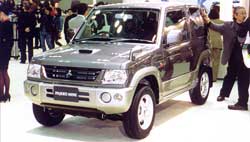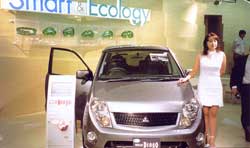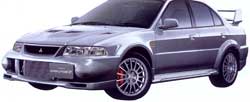Mitsubishi at the Tokyo Motor Show
Barry Jordan was at the Tokyo Motor show and got a glimpse of what Mitsubishi plans to offer Gulf drivers in the not-so-distant future
 Although manufacturers from all over the world were there in force the show was really an opportunity for Japanese carmakers to display their latest ideas. Not surprisingly, because Japan imports 99 per cent of all its oil, many of the cars were small and economical models, with a surprising number of them designed to run on fuel cells or battery power, rather than petrol.
Although manufacturers from all over the world were there in force the show was really an opportunity for Japanese carmakers to display their latest ideas. Not surprisingly, because Japan imports 99 per cent of all its oil, many of the cars were small and economical models, with a surprising number of them designed to run on fuel cells or battery power, rather than petrol.
Although a number of other international motor shows around the world are bigger than this one, more people visit the Tokyo Motor Show than any other. In 1997, for example, a staggering 1.5 million visitors - mostly Japanese - visited the show, which should indicate the interest and sales of Japanese made cars. But the sale of Japanese cars in the domestic market has declined by 8.4 per cent in the first threequarters of 1999, while in the same period there was an increase of 3 per cent in the number of foreign cars sold in Japan.
Despite this, Japanese vehicles still account for 80 per cent of all vehicles sold throughout the GCC countries. I asked one executive for an explanation and he answered in one word, "price." Because Japanese vehicles are all made to a certain standard - most have electric windows and wing mirrors, efficient air conditioning, reasonable performance, good fuel consumption and they retain a good resale value, they've earned a reputation as "a good buy" irrespective of the name on the front of the bonnet.
Mitsubishi placed most emphasis on its Smart Utility Wagon series. The SUW Compact has been designed for use in urban areas and features a GDI Stop and Go engine as an environmentally friendly feature. Believe it or not, this engine stops automatically at red traffic lights and starts again when they turn to green! Another SUW, the Active, is fitted with tyres that, if punctured, can be driven at up to 90 km/h for a distance of 80 kms. There were also new versions of the Pajero on show including the New Pajero Short Super Exceed and Long Super Exceed, both of which feature new engines and body design.
As the names suggest, the vehicle is available in two versions. The Short Exceed is equivalent to the current Pajero SWB, has three doors and is powered by a 3.4 litre engine. It has a maximum output of 162kW at 5,500 rpm and maximum torque of 348Nm.
The bigger, 5-door Long Exceed has been fitted with a 3.2 litre direct- injection diesel engine. It's an in-line 4-cylinder 16 valve unit with an intercooler-turbocharger, which generates a maximum output of 129kW at 3,800 rpm and has a maximum torque of 382 Nm. The engine has been built to meet new Japanese emission standards that call for a 60 per cent reduction in black smoke. In other words, this is a new diesel engine that should remove for ever the belief that diesel engines are dirty.
 Both these high-output, low-consumption engines underscore Mitsubishi's commitment to build new, more environmentally friendly vehicles. Performance on and off road has been improved by the use of enhanced component systems. A new 4 wheel-drive transmission splits torque between the front and rear wheels to match surface and driving conditions, while the hybrid slip differential maintains traction and operates in conjunction with anti-lock braking.
Other changes include a new, lightweight body; better aerodynamics; improved noise and vibration proofing and a new independent suspension system that gives a more comfortable ride over rough terrain
Both these high-output, low-consumption engines underscore Mitsubishi's commitment to build new, more environmentally friendly vehicles. Performance on and off road has been improved by the use of enhanced component systems. A new 4 wheel-drive transmission splits torque between the front and rear wheels to match surface and driving conditions, while the hybrid slip differential maintains traction and operates in conjunction with anti-lock braking.
Other changes include a new, lightweight body; better aerodynamics; improved noise and vibration proofing and a new independent suspension system that gives a more comfortable ride over rough terrain
In the five-door version the third row of seats stows under the
floor to give greater luggage capacity and the rear doors have been widened to improve access to the rear cabin. There's a new door design on the three-door version too, which gives easier access to the rear seats. Both models have improved passenger entry and exit characteristics thanks to a lower floor height, while rear visibility has been significantly improved due to the lowering of the spare tyre housing. There's a bigger glassed tailgate window as well.
The three-door version can comfortably seat five people, while the five-door version is a true seven-seater.
The diesel version is a smooth performer with good acceleration, while the 3.4 litre petrol engine in the Pajero Short Exceed gives improved acceleration and pulling power, while when driving off road both versions perform extremely well and offer a degree of comfort that was lacking in the earlier models.
The three SUW's, Advance, Compact and Active also attracted considerable attention.
The Advance is fitted with a hybrid GDI-HEV engine system. Put simply this is a 1.5 litre direct injection engine that is coupled to a small capacity motor-generator. Together they produce high output and low fuel consumption. Its superior combustion technology can alter the air-fuel mixture. Drivers are able to choose between normal and power modes. In the normal position the car delivers 31.5 km per litre, while in the power mode the motor-generator torque supplements the engine torque. This provides a power range in excess of cars with larger engines.
Other advantages include the design - a compact car that comfortably seats five people; the latest safety technology features; wide opening double doors and seats that can be folded and stored when not required, giving the Advance numerous seating arrangements. The Compact SUW is a small town-car described by Mitsubishi as a 'smart urban runner.' The 1.1 litre is fuel efficient and uses low-emission technology and is equipped with a system that automatically stops and restarts the engine in city use, such as at traffic lights. New technology includes front airbags and side airbags that are built into the front seatbacks.
A 'stress-free all round sports utility' was the development theme for the SUW Active, which provides generous interior space combined with a nimble performance. The car is powered by a 2.0 litre GDI turbo engine matched to a Sport Mode 4-speed automatic transmission. As well as returning low petrol consumption, the engine delivers a powerful performance.
These are just some of the new vehicles revealed by Mitsubishi at the Tokyo Motor Show, all designed with two key phrases in mind - Smart Design and Ecology Conscious.
Smart Design fulfills Mitsubishi's goal of enabling drivers and passengers to enjoy their journeys in stress-free comfort and safety. Ecology Conscious incorporates the use of low-consumption, low-emission GDI engines and the development and application of new technology to make Mitsubishi vehicles more environmentally friendly.
It's not yet known which of these technologically advanced vehicles will be sold in the Gulf region, but what is certain is that when they are, they will be just as successful as earlier Mitsubishi models - but with a hint of what is to come in the 21st century.
|
Lancer Evolution
 Al Habtoor Motors are offering the UAE's drivers the chance to own the latest edition of the Mitsubishi Lancer Evolution. The Evolution VI is a ready-to-race limited edition version of the car Tommi Makinen has driven to three World Rally Championship victories. The Lancer Evolution's engine is a 2000cc DOHC ECI-MULTI with an intercooled turbocharger. Would-be rally drivers can contact Al Habtoor Motors in Dubai on +971-4-691110 to find out how to own one. Al Habtoor Motors are offering the UAE's drivers the chance to own the latest edition of the Mitsubishi Lancer Evolution. The Evolution VI is a ready-to-race limited edition version of the car Tommi Makinen has driven to three World Rally Championship victories. The Lancer Evolution's engine is a 2000cc DOHC ECI-MULTI with an intercooled turbocharger. Would-be rally drivers can contact Al Habtoor Motors in Dubai on +971-4-691110 to find out how to own one. |